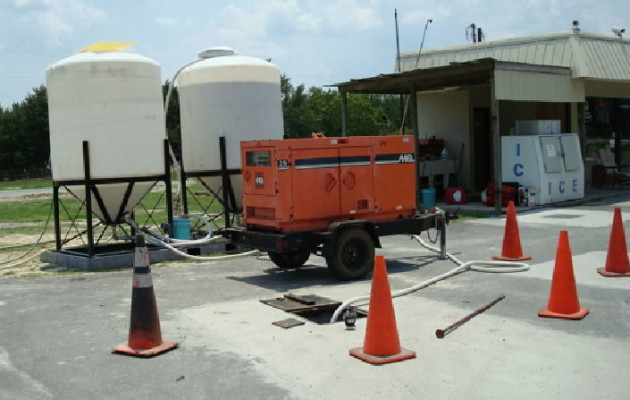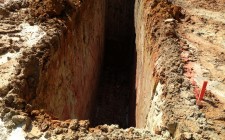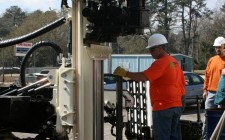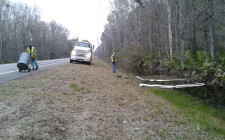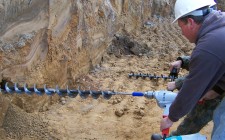The Johnson & Johnson #6 facility (Site) is located on the east side of State Road (SR) 255 just north of the I-10 and SR-255 intersection, Lee, Madison County, Florida. This site historically operated as a convenience store providing unleaded gasoline and vehicular diesel from above ground storage tanks (AST). The ASTs were installed in July 1975.
After evaluating the existing data, Fortis consulted with Tri-Con to assist in the development of an innovative remedial design that would meet both the FDEP cleanup requirements for the site and not impact the site business.
In October 2007, Fortis submitted the Remedial Action Plan for installation of a permeable barrier treatment partition (PBTP). The plan was approved in January 2008 and implemented in spring of 2008.
The remediation implementation activities included limited excavation of the petroleum source contamination in the vicinity of both existing dispenser islands and the AST containment dike. The source removal was conducted using
26 large diameter auger (LDA) borings; the LDA was also utilized during the installation of the PBTP network. Activities were conducted in two phases and, as with all invasive work, utility clearances and a pre-construction meeting were held prior to start of onsite activities.
Phase I focused on direct push technology (DPT) soil screening to refine the PBTP locations and design, followed by the installation of the PBTPs. 26 soil borings were advanced and continuously screened. The data was sent daily to the engineer of record for review. Once the soil borings were completed, the data was used to develop a specific design for each of the 26 PBTP locations.
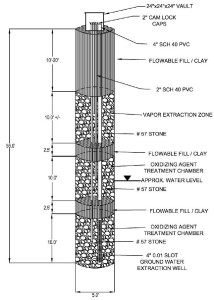 The PBTP cells were spread across the site, perpendicular to groundwater flow, in nine rows. Once each individual design was completed, the LDA was utilized to excavate to 55 feet bls (approximately 49 cubic yards of contaminated soil). The excavated soil was characterized and disposed off site. An added benefit of the LDA PBTP installation was the direct removal of potential source material. The PBTP was then constructed in the open LDA hole. Each PBTP cell consists of two to three several chambers filled with # 57 stone. The chambers are segregated with seals (flowable fill) and PVC wells have been placed in each chamber. The individual chambers in each PBTP cell were designated for use as vapor extraction cells, groundwater extraction wells, or injection zones for oxidizing agent; each PBTP could be used for as many as three different remedial technologies.
The PBTP cells were spread across the site, perpendicular to groundwater flow, in nine rows. Once each individual design was completed, the LDA was utilized to excavate to 55 feet bls (approximately 49 cubic yards of contaminated soil). The excavated soil was characterized and disposed off site. An added benefit of the LDA PBTP installation was the direct removal of potential source material. The PBTP was then constructed in the open LDA hole. Each PBTP cell consists of two to three several chambers filled with # 57 stone. The chambers are segregated with seals (flowable fill) and PVC wells have been placed in each chamber. The individual chambers in each PBTP cell were designated for use as vapor extraction cells, groundwater extraction wells, or injection zones for oxidizing agent; each PBTP could be used for as many as three different remedial technologies.
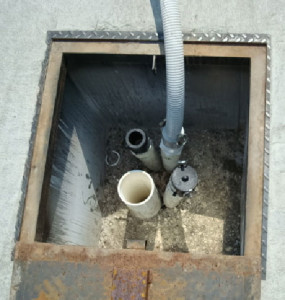 Phase II consisted of implementation of the in-situ remediation activities. Shallow PBTP chambers were originally designed for vapor extraction (VE). However, the Phase I soil data did not indicate the presence of sufficient shallow soil contamination to warrant the cost of a vapor extraction system. Several VE-capable chambers were installed at the highest soil screening locations for possible future use as passive vents or for injection. Central and select deep PBTP chambers were utilized for the injection of calcium peroxide. The location of each chamber and the high transmissivity of the chamber construction allow groundwater to preferentially flow through the PBTP cells. During the injection activities, the calcium peroxide slurry (CPS) was pumped into select PBTP chambers. Each chamber has a 588 gallon capacity, so a 20 percent overfill margin was added and 700 gallons of CPS was pumped into each chamber.
Phase II consisted of implementation of the in-situ remediation activities. Shallow PBTP chambers were originally designed for vapor extraction (VE). However, the Phase I soil data did not indicate the presence of sufficient shallow soil contamination to warrant the cost of a vapor extraction system. Several VE-capable chambers were installed at the highest soil screening locations for possible future use as passive vents or for injection. Central and select deep PBTP chambers were utilized for the injection of calcium peroxide. The location of each chamber and the high transmissivity of the chamber construction allow groundwater to preferentially flow through the PBTP cells. During the injection activities, the calcium peroxide slurry (CPS) was pumped into select PBTP chambers. Each chamber has a 588 gallon capacity, so a 20 percent overfill margin was added and 700 gallons of CPS was pumped into each chamber.
Injections were completed in June 2008. Initial groundwater sampling results were very positive with order-of-magnitude reductions in groundwater contamination.
